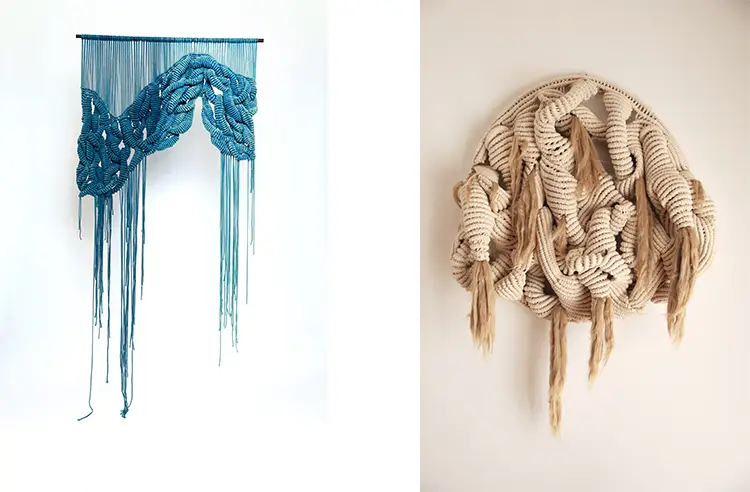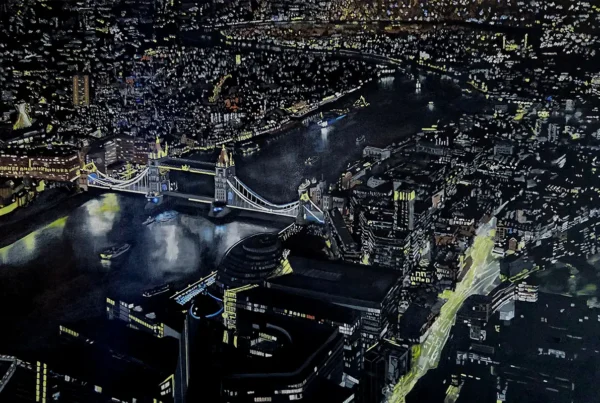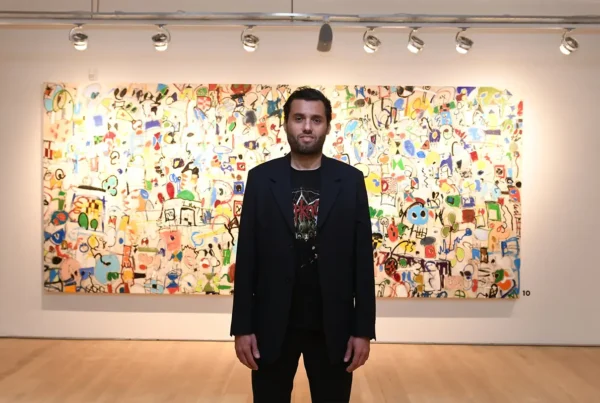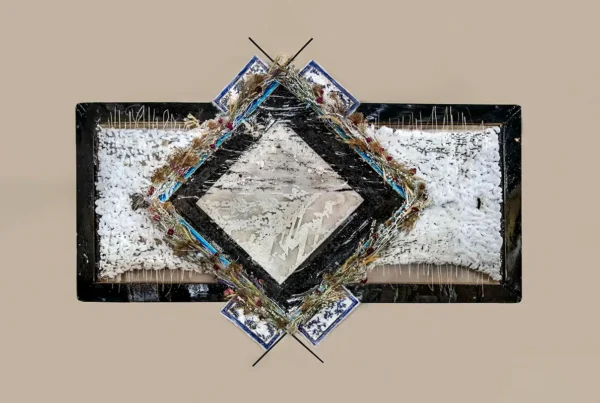“The piece resonated widely, affirming for me that textiles can convey universal emotions through intimate, tactile gestures.”
Threading Memory Through Silence and Soil
In a quiet forest studio nestled within a yurt, textile artist Vânia Reichartz has crafted a world where memory, identity, and transformation converge through fiber. Working in solitude and surrounded by nature’s rhythms, she creates tactile works that feel both ancient and startlingly contemporary. With roots that span Portuguese and German cultures, Reichartz draws deeply from personal experience, infusing her materials with the emotional textures of motherhood, loss, and healing. Her work doesn’t just occupy space—it seems to breathe within it, each thread vibrating with the resonance of what has been felt, remembered, or mourned.
From an early age, yarn and fabric held meaning far beyond their physical properties. Introduced to weaving through her mother, Reichartz later pursued formal training in Lisbon, refining her skills in tapestry, weaving, and printmaking. Though she explored scenography and theater design in both Portugal and Germany, it was textile work that offered her the most authentic mode of expression. Within this medium, she found the capacity to hold fragility and resilience side by side. Her shift from stage to studio wasn’t a retreat but a return—one that allowed her to translate intangible memories into tangible, expressive forms.
Today, Reichartz’s artistic practice is inseparable from her environment. Her yurt-studio, cocooned by trees and silence, provides the conditions for an intuitive, meditative process. Natural surroundings dictate the pace of her work, guiding her toward forms that grow organically, often beginning with color and unfolding through repetition. This rhythm—a dialogue between body, fiber, and environment—underscores her belief in textiles as vessels of continuity and restoration. Rather than impose structure, she listens to the material, letting each knot, fringe, and coil emerge as a whisper of the past or a gesture toward healing.
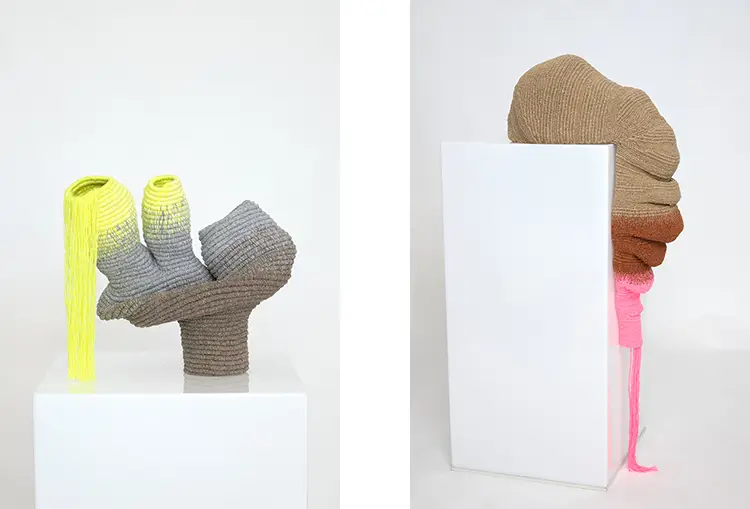
Vânia Reichartz: A Practice Woven from Life’s Threads
Textiles, for Reichartz, are more than materials; they are extensions of touch, memory, and presence. Her style is defined by an unwavering commitment to handwork, with organic shapes, layered textures, and biomorphic forms that echo the softness of the human body and the wildness of the forest. Employing tapestry weaving, macramé, basketry, and other techniques, she assembles works that are physically intimate yet expansive in meaning. Each piece is crafted slowly, with intentionality, allowing emotion and intuition to guide the process. Fragility and transformation remain constant themes, grounded in her lived experience and her reverence for the sacred within everyday gestures.
Her creative influences span a wide artistic spectrum. Magdalena Abakanowicz’s spatial fiber forms, Sheila Hicks’s vibrant abstraction, and Louise Bourgeois’s emotional resonance serve as touchstones. Reichartz also draws inspiration from figures like Mrinalini Mukherjee, Aurelia Muñoz, Tadek Beutlich, Sonia Delaunay, and Hilma af Klint—artists who blurred the boundaries between art, craft, mysticism, and the body. Beyond formal aesthetics, life itself continues to shape her vision. Years spent in Germany broadened her sense of cultural identity, while motherhood intensified her connection to cycles of creation and renewal. Personal experiences of grief have deepened her engagement with themes of impermanence, giving her work an emotional weight that transcends the visual.
Two pieces stand as turning points in her artistic journey. Mother and Father, constructed from natural fibers and diverse weaving methods, captures both presence and absence in its intertwining of memory and form. The piece’s emotional immediacy struck a chord with audiences, reinforcing Reichartz’s belief in the power of textiles to express universal human emotions through intimate gestures. Amarrador, another significant work, marked her foray into reinventing traditional macramé knots, opening up a new visual vocabulary. Both works signify a moment when her personal narrative and artistic language became indistinguishable—woven together into something raw, honest, and transformative.
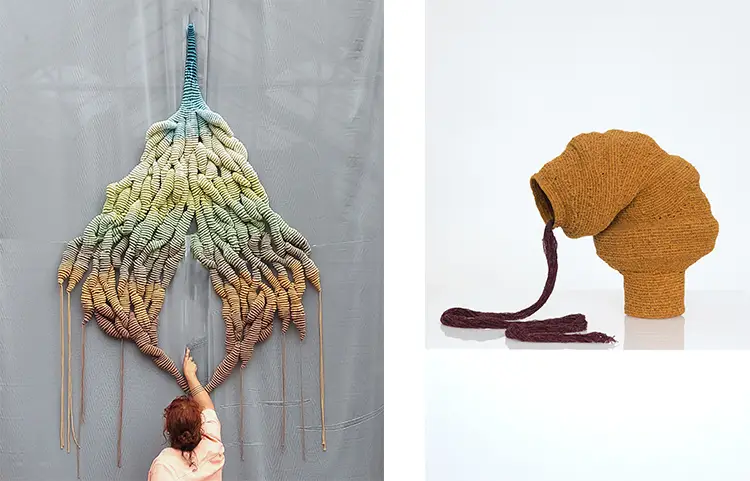
Sensual Structures, Emotional Landscapes
Reichartz’s textile language pulses with vitality. Her aesthetic leans into biomorphic abstraction: swelling contours, vine-like appendages, and cellular motifs that appear to grow or disintegrate before the viewer’s eyes. These forms are neither strictly decorative nor overtly representational; instead, they exist in a liminal state, suspended between being and becoming. The use of fringe, droop, and layered threadwork introduces an element of motion, suggesting that her sculptures are not static but evolving. Each knot and loop retains the imprint of the hand, yet collectively they echo something larger—a body, a memory, or an emotion held in time.
Her sense of color is instinctive and responsive. From deep ochres and earthy greens to luminous pinks and skin-like neutrals, her palette speaks the language of sensation. Yet despite their richness, her hues never overpower the material. Fiber is treated with respect, its natural texture preserved rather than masked. This honesty of material becomes central to her process, reinforcing the emotional sincerity of each piece. Her works often evoke domesticity and labor, yet never reduce these to clichés. Instead, they elevate the acts of knotting, weaving, and binding into rituals of creation and remembrance.
The emotional architecture of her work is undeniably shaped by her background in theater and scenography. Sculptural wall pieces often possess a theatrical sense of presence, yet their drama arises from emotional nuance rather than spectacle. These are not props but protagonists—forms that carry the weight of personal and collective stories. Reichartz brings a performative sensibility to static objects, imbuing them with a sense of movement and breath. The result is work that feels inhabited, as though each thread carries the memory of touch and each form shelters an unseen narrative waiting to unfold.
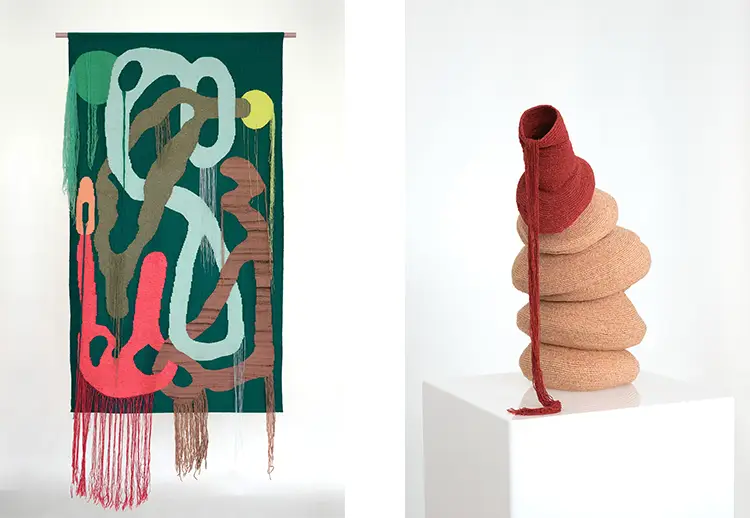
Vânia Reichartz: Between Craft and Invocation
Reichartz’s studio practice unfolds with a ritualistic cadence. Solitude, silence, and environmental sensitivity guide her hands as she builds immersive pieces from thread and fiber. Her process is inherently embodied, driven by intuition and the tactile intelligence of the hand. She often begins with color, letting it lead her toward form, while repetition in technique serves both as meditative anchor and structural foundation. The act of making becomes a space of listening, where rhythm and gesture converge into something quietly profound. In this way, her pieces function as both object and invocation—material offerings born from a deeply personal inner landscape.
Her vision for the future points toward expansion. She intends to develop larger-scale installation works that envelop the viewer, inviting them to step inside environments shaped entirely by fiber. These immersive settings are not merely aesthetic experiences but emotional terrains where memory and touch coalesce. By blending traditional craftsmanship with abstract spatial compositions, Reichartz seeks to build spaces of belonging—structures that offer not only visual impact but emotional resonance. Her ambition lies in inviting others into the intimacy of the handmade, forging connections through the universal languages of texture, form, and memory.
Ultimately, what sets Reichartz apart is her unwavering belief in the hand as a vessel of meaning. In an age of digital overload and mass production, her insistence on slowness, intention, and tactility feels radical. Each piece she creates is not only a statement but a practice of care—care for material, for memory, and for the act of making itself. Through this approach, Reichartz transforms textile art into something more than visual—it becomes a sensory, emotional, and almost sacred encounter. Her work asks us to pause, to feel, and to remember that within every thread, there is a story waiting to be held.
